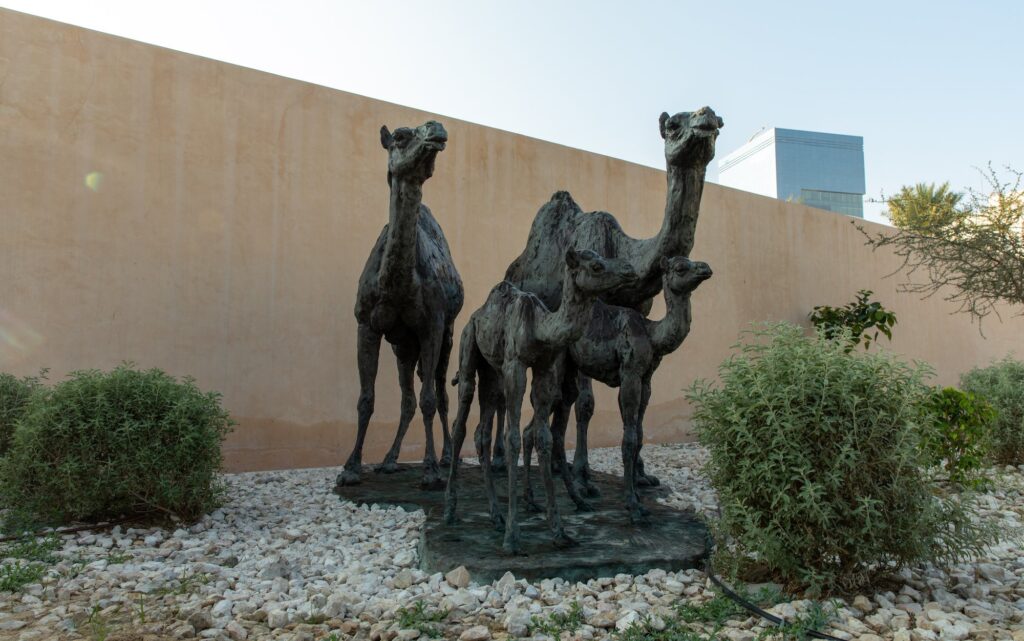
The public installation “On their Way” was created by a French artist, Roch Vandromme, and was installed in Qatar (National Museum) in early 2009. The sculpture vividly mirrors the enriching culture of Qatar, which comprises the figure of four camels that represent the continuation of the dynamic relationship between humans and camels. Roch Vandromme usually dedicates his works for animals in their natural habitat and surrounding; and his artistic intentions behind “On their Way” is a superb embodiment of portraying Qatar’s long history of nomadic lifestyle and the human-camel progressive relationship over time.
Looking closely at the camels, Vandromme has given them life in bronze sculptures, and his purpose behind the absence of humans in this sculpture is very deliberate. In fact, it is the absence of humans that infers the rejection of ‘human exceptionalism’ as rightly suggested in the article, “Interspecies Diplomacy in Anthropocenic Waters” by Una Chaudhuri. The very first phrase of her article, “Yes, animal, what a word!” is more or less equivalent with Vandromme’s artistic intentions behind this sculpture while acknowledging the significance of camels in Qatar’s history and culture. And perhaps, in this context from Vandromme’s perspective, it would be “Yes, camel, what a word!” – implying to the fact that camels are indeed extraordinary animals; and humans especially the people of Qatar must acknowledge and appreciate the dynamic relationship between themselves and the camels. Thus, this blog will explore both the advantages and disadvantages of establishing the interspecies diplomacy with a view to the sculpture “On Their Way” and the article “Interspecies Diplomacy in Anthropocenic Waters”.
Una Chaudhuri explicitly argues in her article that even though our anthropocentrism is obstructing us from building that interspecies relation, our “deep-rooted” and “nature-affirming” outlook must enforce us to connect with the “earthly realities”. This argument may be supported by Roch Vandromme in making the sculpture, since he also intends to depict the close relationship between humans and camels, while creating these majestic camels essence. And moreover, Vandromme found the ‘connection to the earthly realities’ exceptionally significant, because this French artist visited Qatar, explored its enriched heritage, and discovered the strong bond of humans-camels; and thereby, this sculpture is till to date holds a very vital connotation that involves both the preservation of Qatar’s heritage as well as the exhibition of interspecies diplomacy.
Nonetheless, it is important to consider the consequences of the interspecies diplomacy that can harm both the humans and nonhumans species, such as the outbreak of zoonosis from animals to humans, or even the transmission of pathogens from humans to animals. That is why, there is really no any correct or true conventional way of establishing the relationship of human-nonhuman worlds. It is because even though different species rely on each other’s diplomacy, most of the times it is important that our respective natural habitats and ecosystems are valued and not disturbed. However, linking it back with the Vandromme’s work, it seems that his sculpture is in fact representing the camels in their truest natural state, the presence of two generations of camels portraying the continuation of the close relationship between humans and nonhumans, but most importantly, the title of this sculpture “On Their Way” vividly implies to how camels were indispensable to Qatar’s culture and they were indeed ‘on their way’ making people’s lives easier by providing all the necessities.
Bibliography:
- “Ocean-Oriented Ontologies: Performing Interspecies Diplomacy in Anthropocenic Waters.” I Routledge Companion to the Environmental Humanities, edited by Ursula Heise. 2017.
- “Roch Vandromme » On Their Way (2013).” Accessed October 16, 2022. https://roch-vandromme.com/musee-national-du-qatar/?lang=en.